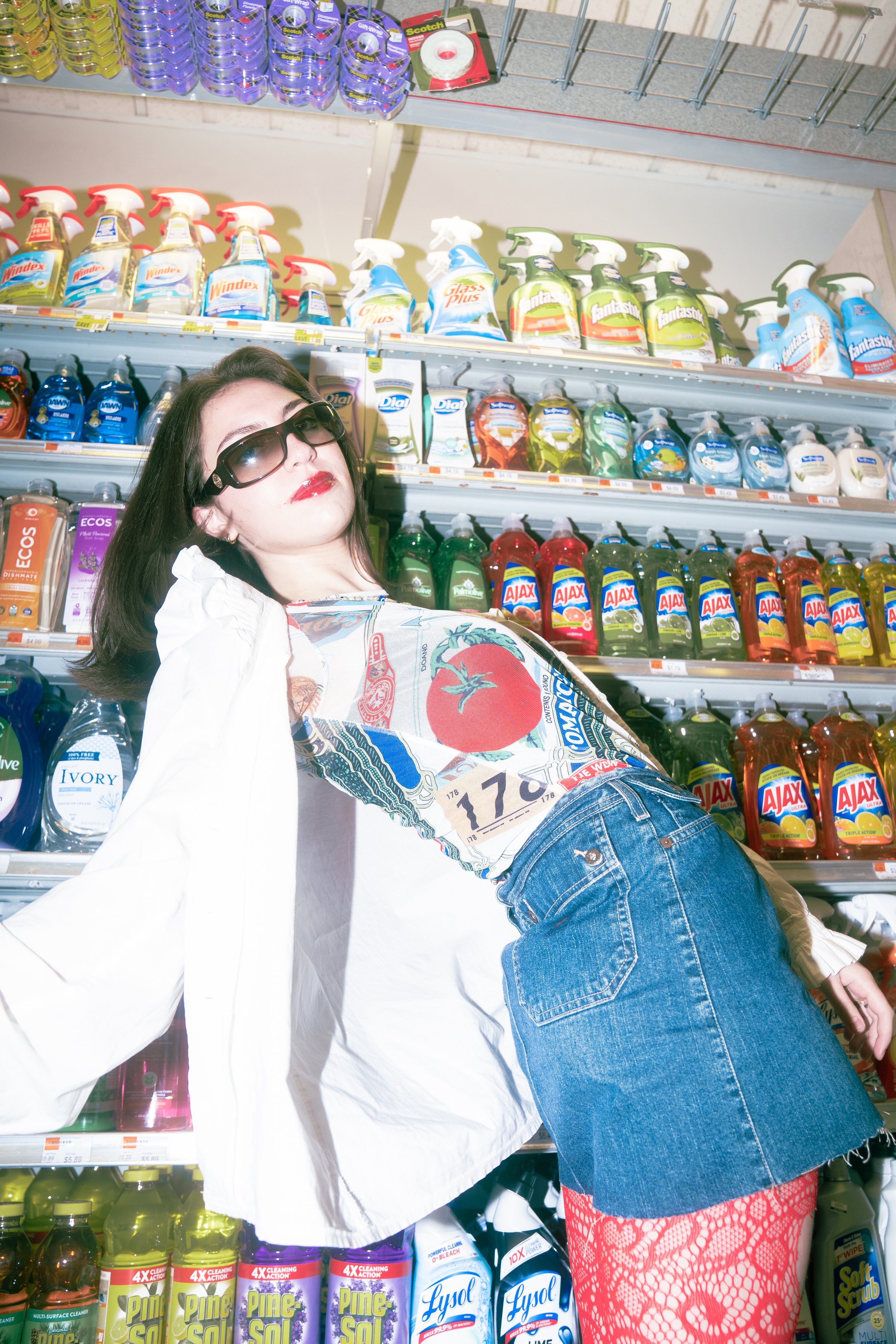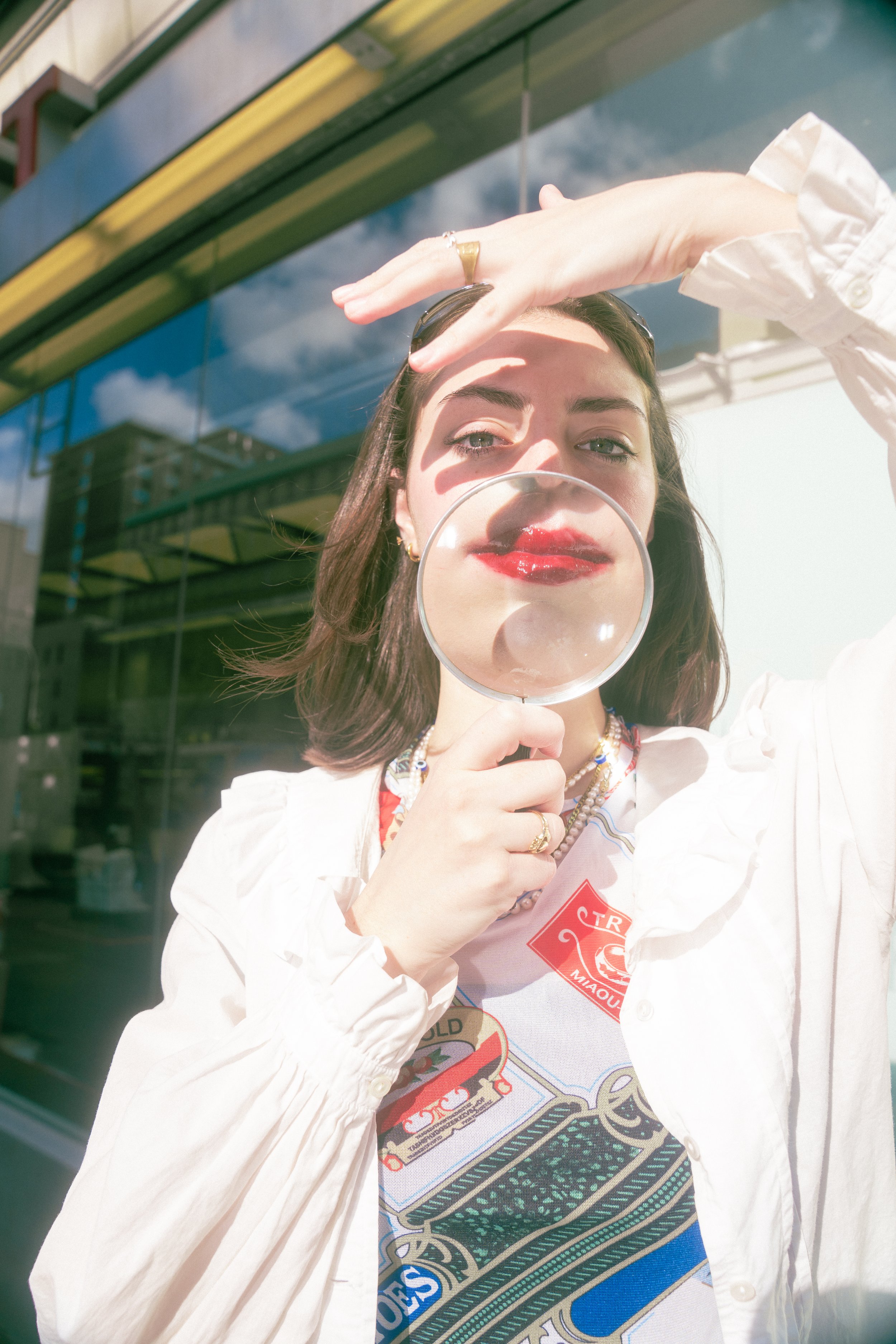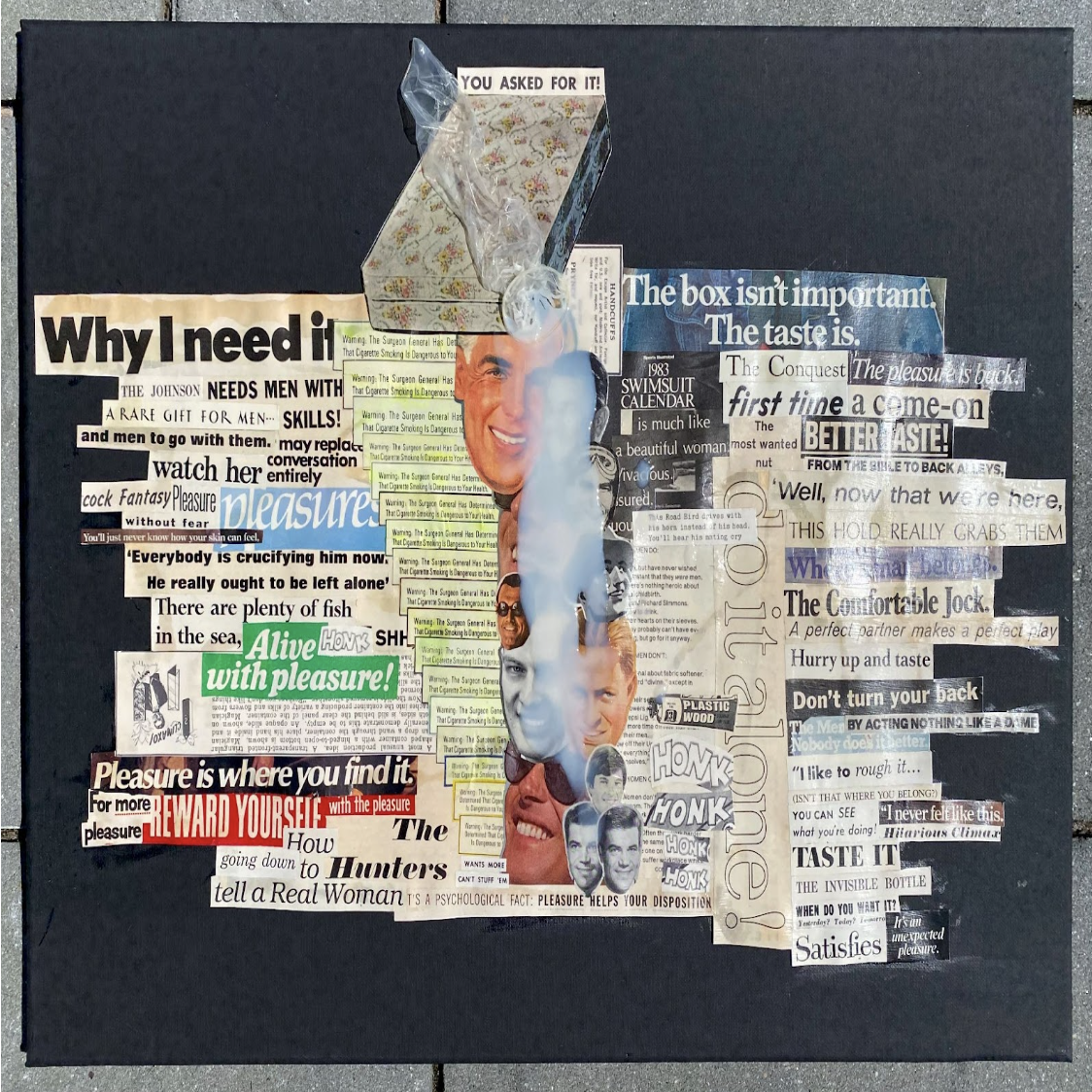Feature by William Lyman
Photos by Rommel Nunez
Kate is a junior in CC majoring in Art History. She is a photographer and collage artist, heavily influenced by 20th century feminist photographers, vintage media portrayals of gender, and creating art from absurdity.
I’m late to Max Caffe, where, apparently, the vibes are “so good.” I send a precautionary text to Kate, who assures me that she’s enjoying the ambiance and doing some reading. I’ve known her for a year or so, and in that time I’ve recognized her as a character of casual coolness––stumbling upon a trendy brunch spot in the Lower East Side or going to cafes to do some leisure reading. She helped me arrange my apartment last summer and got us free drinks one strange night at Cowboy Jack’s. When I finally arrive, she’s stirring a half-full latte, dressed in a black blazer and pearl necklace. We briefly discuss our days, the weather, and 35 millimeter photography. I order an iced tea––which seems to annoy the barista––while Kate catches me up on what she’s been consuming lately: Circe by Madeline Miller, Phoebe Waller-Bridge in Fleabag, and Neftlix’s The Crown. “I know there’s a little shame in that,” she explains, “but when you take the Royal family and put pretty actors in their place, how could you not feel a little obsessed with the glamor of it?”
In fifth grade, Kate was convinced that she would be a fashion designer. “I carried around a little notebook all the time where I drew all my designs. I would compete with this other girl in my class. She was a much better illustrator than I was,” Kate tells me. The story serves as her first memories of herself as a creative, someone who had the desire to attach herself to art. “I always wanted a creative outlet,” she explains, “but I think I needed some instruction. I needed some pushes.” In her younger years, Kate excelled at math and science. She tells me that “the narrative was that I should do those things just because I could” and as a result, “art definitely fell to the wayside.” This path led her to studying applied physics for her first two years at Columbia, which she ultimately left to instead pursue Art History. She pauses and says: “I certainly do not consider myself a scientist these days.”
It wasn’t until her sophomore year, in the early days of the Covid pandemic, that she found what she loved to do––collage. Like us all, Kate was left with lots of free time on her hands. She explains: “I'd been making art for so long, and really everyone who makes art is an artist. Sometimes it feels like a title that someone else bestows upon you, but I didn’t really have time to wait for that.” Living in the city, there was essentially nothing to do––“we couldn’t really go anywhere or do anything on a Friday night,” she explains. Kate talks fondly of nights at the Mexican Deli on 104th Street––eating tacos, grilled cheeses, fries, and Angry Orchard Rosé while collaging with her roommate. “Such a specific drink for such a specific time,” she says nostalgically. On these nights, Kate realized her love for the art form, of combining elements on the page. On collage, Kate says: “that’s where I started taking it seriously.”
Kate began to collage using vintage magazines, original film photography, and materials she gathers during her daily life. “Texture is something that draws me,” she explains, as it is a representation of repurposing different elements. Kate continues: “Relation. Juxtaposition. Putting things together that aren't supposed to be together. I love that. That’s what draws me to art––the relationships between elements of the work and feeling unsettled by the things that have been put together.”
When consuming art, Kate is “always drawn to work where you can understand what went on behind the scenes, where you can feel their hands in the work.” When I ask about her relationship to the world of digital collage, Kate pauses. “It feels like there's something missing for me,” she says, “there's this flatness that I don't like.” Kate appreciates art “as an escape,” and asserts that when she creates, she simply doesn’t want to look at another screen. She explains: “I do think some of my distaste for digital collage comes from that exhaustion of being on my phone, always consuming digital media.”
Footage Fetish is a combination of film, sheet music, and exaggerated body parts. At Mother of Junk in Williamsburg, the place she credits for a lot of her discoveries, Kate stumbled across an antique dollhouse. She shot the house on 35 millimeter film, then combined it with another set of photos––a halloween wig sitting on a makeup mirror––to create the illusion of people in a living room. “My other projects have been a lot more drawn out and conceptualized,” she explains, “but with this one, I picked up two magazines and sat down, thinking: ‘I need to make something right now.’ It was a frenzy, a 45 minute cutting and gluing moment.” When asked what she hopes people will take away from the piece, she explains that: “I want people to interact with and engage with these works, but I don't need them to feel the same way I do about it.” It’s one of the things she loves about art––that “there is no right answer.”
In discussing her other influences, Kate seems to arrive at something essential about her work––highlighting the absurdity of cultural messages directed to women. Specifically, how these ideas have evolved through time. Kate discusses the trope of the “femme fatal” and its roots in Greek and Roman mythology––“Medusa, Circe, and other female characters who pose these mortal threats to men.” Kate traces this portrayal to film tropes, beauty advertisements, and media representations throughout the 20th century and into modern day. “The love of my life is Laurie Simmons,” Kate gushes. Simmons rose to prominence in the mid-1970s, critiquing women’s role in the domestic sphere through the use of doll parts, ventriloquist dummies, and toys. Kate cites Laurie’s series on the Stettheimer Dollhouse as a major influence on her work.
“The absurdity of these magazines speaks to me because there's so much content being created today. I'm interested in analyzing these old forms of media as a root of a lot of the problems in our society today, the way they've developed and progressed,” Kate explains. In examining these mid-century magazines, Kate is conscious of the fact that “so much of it feels like satire now,” but traces this back to the small breadth of information available. “People were solely consuming these magazines,” she begins, “just completely in the dark from all the other information and perspectives that were out there. They’re like a Bible in many ways.”
The absurdism in beauty advertisements and cultural messaging is “super different today, because it's much more self aware,” Kate continues, “they're the same, but just coded.” I ask her about the vintage craze, about the age-old question of trendy thrifting––the buzz-words “curated vintage”––and she laughs. To me, there seems to be a great deal of absurdity in that concept, too––the anti-influencer who encourages the masses to search for character––how the past few years have seen a rise in uniqueness as a trend. “Of course, there's no freedom from these industries. You are always in the product, whether you choose to buy into it or not. We're always being influenced. The question is how you respond to it.” Kate poses an important question: “If you’re an amalgamation of the things that you've absorbed––is that not an identity?”
“During the summer going into sophomore year,” she begins, “a friend of mine from London came to visit and we had this really cool fun week in New York. We went to Chelsea market and I found this gold, embossed leather notebook.” She speaks hypothetically about this first journal, pulling a different book from her tote bag, opening it to reveal pages of collage and handwritten reflections. Her cursive intimidates me. “I started writing and I never stopped. That was four journals ago” she says. Kate takes me on a tour of her current journal, which is filled with scraps of paper, ink from brightly-colored pens, and film photos. Kate explains how the journal is home to many of her collage elements––film she had accidentally bought, a chapter-long meditation on Sappho, random song lyrics she connects to, or phrases she came across and wanted to remember. The journal even includes her Footage Fetish collage we had just finished discussing. It becomes clear to me that her journals are the centers of her creativity––where she collects and meditates on everything going on around her.
“It's so much fun. I love collecting things. I love looking back at them,” Kate tells me. She pulls out her phone and scrolls through her camera roll, looking for something. “My grandfather died recently, and we were cleaning out his house,” she explains, “my grandparents never cleaned out their closets and so there's so much crazy stuff.” Kate finds what she had been looking for, turning the screen to reveal a picture of a brown restaurant napkin. On it, written in blue ink, was:
“Flesh and corruption were the same from the very beginning, and always will remain the scum of creation, the very opposite of God's wisdom, mercy and splendor . . . Man would manage somehow to crawl upon the surface of the earth, forward and backward, until God's covenant with him ended and man's name in the book of life was erased forever.”
It was a quote from The Death of Methuselah, a short story collection about Jewish folklore and legend. Kate smiles: “that was just written on a napkin, saved in the closet for years. It's one of my favorite things that I've ever held.”
Returning to her journals, Kate levels with me. She says: “I'm opening this up and it's also all of my deepest, dark secrets. I would never say them to anyone out loud.” Kate continues: “The purpose of writing is not to have it read, but to get it out. I find a lot of clarity in writing. I don't write anything particularly creative. I really just write about my life. It's about leaving a record of a past,” she tells me. I prod Kate for further information on the journals. She explains: “they were the main thing I created for a really long time, and it was the only place I felt like I could create. In my will, the journals need to be burned. I think it's important to have that place that you trust too much. I think that there has to be a space where there's no restrictions. There's no limitations on what you can say or do.”
Holding this fourth journal, that I learned she got on a January 2020 trip to Peru, I come to understand a lot about Kate––how she is actively working to make her life a work of art. She collects ticket stubs, ominous blue-inked napkins, expired film, cut up magazines, reflections on her life experiences––she is in the business of building a rich record of her life. Her journals are the original form of collage, as they are responsible for taking her experiences with friends, the city, literature, influence, and cultural messaging and turning it into a representation of her identity. “I'm just a girl who's consuming everything else around me and putting it together, maybe cherry picking content, ideas, and visual concepts that speak to me. That is a part of who I am.” It is how she deals with the absurdity of modern existence––recognizing her identity as a form of collage, of something accumulated through her experiences.
Find Kate @kkatemiller on Instagram.






































